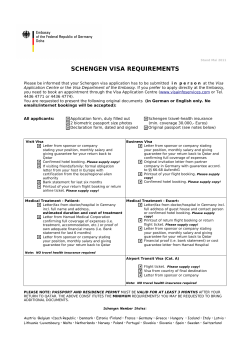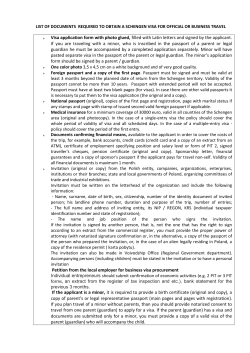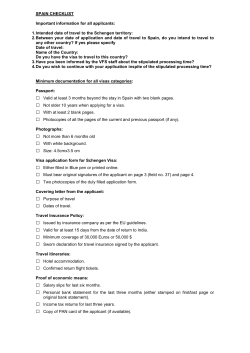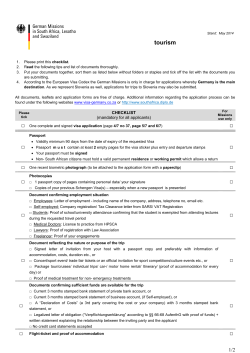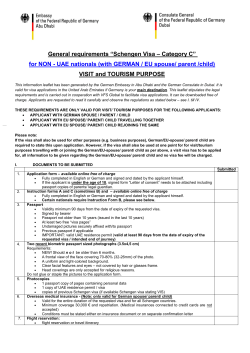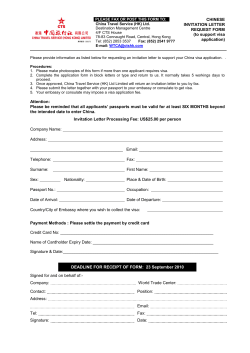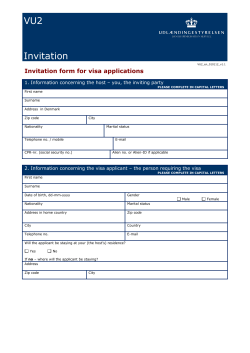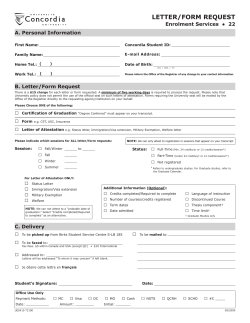
Schengen Area The
Schengen Area The Schengen Area as of 12/12/2008 IS ■ EU Schengen Member States ■ Non Schengen EU Member States ■ Non-EU Schengen Member States FI NO 2 BE: Belgium BG: Bulgaria CZ: Czech Republic DK: Denmark DE: Germany EE: Estonia IE: Ireland EL: Greece ES: Spain FR: France IT: Italy CY: Cyprus LV: Latvia LT: Lithuania LU: Luxembourg HU: Hungary MT: Malta NL: Netherlands AT: Austria PL: Poland PT: Portugal RO: Romania SI: Slovenia SK: Slovakia FI: Finland SE: Sweden UK: United Kingdom IS : Iceland NO: Norway CH: Switzerland Cover © iStockphotos AÇORES (PT) EE SE MADEIRA (PT) LV CANARIAS (ES) DK IE LT UK NL PL DE BE LU CZ SK FR AT CH HU SI RO IT PT BG ES GR EL MT CY Contents © iStockphotos The Schengen Area 4 History of the Schengen Area 6 Framework of the Schengen Area 10 Financial instruments 12 Schengen area in your daily life 14 Good to know 16 3 4 21 December 2007 – Raising the border barrier at Zittau/Żytawa/Žitava during a celebration of a major enlargement © EC of the Schengen area The Schengen Agreement was signed by Belgium, the Netherlands, Luxembourg, France and the Federal Republic of Germany on 14 June 1985. The Schengen Area The Schengen Area guarantees free movement within a territory of 25 countries home to more than 400 million citizens. It is an area with 42 673 km of sea and 7 721 km of land borders. Under the Schengen Agreement, signed on 14 June 1985, five countries committed to the gradual abolition of borders between them, accompanied by more effective surveillance of their external borders. It established: • short-term measures simplifying internal border checks and coordinating the fight against drug trafficking and crime; and • long-term measures such as the harmonisation of laws and rules on drug and arms trafficking, police cooperation and visa policies. The Convention implementing the Schengen Agreement, signed on 19 June 1990, set out how the abolition of internal border control would be applied, as well as a series of necessary accompanying measures. It aimed to strengthen external border checks, define procedures for issuing uniform visas, establish a Schengen Information System (see below) and take action against drug trafficking. The implementation of the Schengen Agreements started on 26 March 1995. Joining the Schengen Area as a full member is not only a political decision. Countries must fulfil a list of pre-conditions, such as the readiness and capacity: • to take responsibility for controlling the external borders on behalf of the other Schengen countries and issuing of uniform Schengen visas; • to cooperate efficiently with law enforcement agencies in other Schengen countries, in order to maintain a high level of security once border control between Schengen countries is abolished; • to apply the Schengen set of rules built up over time (the Schengen acquis) such as for example control of land, sea and air borders (airports); issuing of visas; police cooperation, protection of personal data; • to connect to and use the Schengen Information System. Applicant countries undergo a Schengen evaluation which does not end when they join the Schengen area, but is repeated periodically to ensure that the correct application of the legislation is maintained. 5 History The Schengen Agreement was named after a small village in Luxembourg located on the point where its borders meet those of France and Germany. 14 June / 1985 Agreement on the gradual abolition of checks at their common borders signed by Belgium, the Netherlands, Luxembourg, France and the Federal Republic of Germany. 19 June / 1990 Convention implementing the Schengen Agreement signed by the same countries, confirms the arrangements and safeguards for implementing freedom of movement. It entered into force in 1995. 26 March Starting as an initiative between governments, Schengen cooperation was integrated into the treaties governing the European Union (EU). 26 Oct./1 Dec. / 1997 First move towards the enlargement of the Schengen area: Italy and Austria gradually start to abolish their border controls. This process is completed on 31 March 1998. 1 May / 1999 Integration of Schengen into the legal framework of the EU EU, following the entry into force of the Treaty of Amsterdam. / 1995 Abolition of border controls between Belgium, Germany, France, Luxembourg, the Netherlands, Spain and Portugal. © EC 6 On 17 June 1984, France and Germany, in the margin of the European Council in Fontainebleau, agreed to define new ways of giving impetus to the process of European integration. At the same time, the Benelux countries (Belgium, Luxembourg, and the Netherlands) launched a similar reflection process. They joined France and Germany to define the conditions needed to ensure real freedom of movement for citizens. This led to the Schengen Agreement. of the SchengenArea Second move towards the enlargement of the Schengen area: Greece gradually starts to abolish its border controls. This process was completed on 26 March 2000. 29 May / 2000 Council of the EU decides on UK participation in some Schengen provisions. The United Kingdom is not part of the Schengen area but only participates in certain aspects of the Schengen rules built up overtime, mainly police and judicial co-operation (except elements linked to ‘hot pursuit’). The United Kingdom is not however part of the area without internal border control, nor does it participate in the external border and visa policy. The United Kingdom's formal participation in the approved areas of cooperation was put into practice by a 2004 Council decision that came into effect on 1 January 2005 2005. 22 December 2007 – General view of the ceremony held in Skofije for the extension of the Schengen area 25 March / 2001 Abolition of border controls with Norway, Iceland, Sweden, Denmark and Finland. 28 February / 2002 Council decision on Ireland’s request to take part in some aspects of Schengen, roughly corresponding to the aspects covered by the United Kingdom’s request. The exact date for implementation of the Schengen provisions by Ireland has yet to be set. There is just one minor but important difference between the positions of the UK and Ireland under the Treaty of Lisbon: Ireland’s power to choose when it wishes to opt in will not extend to measures to freeze terrorist assets. Ireland will participate in the adoption and implementation of such measures on the same basis as other Member States. 1 January / 2005 Co-decision applies for adopting measures on the absence of control at internal borders, carrying out checks on people at external borders and on the conditions for third-country nationals to travel freely within the EU for a period of under three months. 15 March / 2006 7 Adoption of the Schengen Borders Code: a Community Code on the rules governing the movement of people across borders – (repealing parts of the Schengen Convention and other Schengen-originated rules on border control). 21 December / 2007 Major enlargement of the Schengen area with the abolition of control of land and sea borders with the Czech Republic, Estonia, Hungary, Latvia, Lithuania, Malta, Poland, Slovakia and Slovenia. Border checks on intra-Schengen flights at airports were abolished on 30 March 2008. View of the village of Schengen © iStockphotos / 2000 © Menn Bodson 1 March 9 July / 2008 Adoption of the VIS Regulation concerning the Visa Information System (VIS) and the exchange of data between Member States for short-stay visas. 8 28 February / 2008 13 July / 2009 Adoption of the Community Code on Visas establishes procedures for issuing visas for transit through or intended stays in the territory of countries applying Schengen rules in full. 1 December Signature of the protocol on the participation of Liechtenstein in the Schengen area. 12 December / 2008 Treaty of Lisbon enters into force. 25 March / 2010 Adoption of EU Regulation allowing holders of national long-stay visas to circulate within the Schengen area. © iStockphotos © Fotolia Abolition of border control at land borders with Switzerland. Border checks on intra-Schengen Switzerland flights at airports abolished on 29 March 2009. / 2009 © iStockphotos 9 Framework of the Schengen Area Born as an intergovernmental initiative outside the treaties setting up and governing the EU, the two Schengen agreements nevertheless entailed concrete political and legal links with the then European Community (now European Union), including a clear reference to its legal framework in the Preamble. It was not meant as an alternative or an obstacle but as a forward looking European experiment aimed at implementing a major objective of the European Community: the establishment of an area without internal frontiers. 10 The two fundamental agreements which originally shaped the Schengen Area are: • the Schengen Agreement of 1985 on the gradual abolition of checks at common borders (Schengen I). • the 1990 Convention which supplements the Schengen Agreement of 14 June 1985 and lays down the arrangements and safeguards for implementing freedom of movement. It entered into force in 1995. INCORPORATING THE SCHENGEN RULES INTO THE LAWS AND RULES OF THE EU Taking advantage of a revision of the EU treaties in the late 1990s, negotiators undertook to incorporate the developments brought about by the Schengen Agreement into the body of rules governing the EU. This included the integration of both the secretariat of Schengen into the secretariat of the Council of the EU and of the so-called Schengen acquis. A protocol defining the condition of this integration was attached to the Treaty of Amsterdam and entered into force together with the new Treaty on 1 May 1999. This integration meant important changes in the way countries in the Schengen area cooperate: notably scrutiny from the European Parliament and the European Court of Justice. It also helped to achieve the objective of the free movement of people enshrined in the Single European Act of 1986. Since 1 January 2005, Schengen rules on borders and free movement are made or changed by both the Parliament and the Council through a decision-making procedure called co-decision. The entry into force of the Treaty of Lisbon on 1 December 2009 made some further structural changes to EU Justice and Home Affairs policies and, as a consequence, to the Schengen acquis. The Treaty of Lisbon facilitates action at the European level, particularly in the area of justice, freedom and security e.g. thanks to the extension of the co-decision procedure - when the European Parliament and the Council voting by qualified majority decide based on a proposal by the European Commission. The co-decision applies to, with some exceptions, the Schengen rules, including police cooperation and judicial cooperation in criminal matters. Some of the exceptions concern provisions on passports, identity cards and residence permits (Article 77(3) TFEU) and the establishment, on the basis of Eurojust, of a European Public Prosecutor (Article 86(1) TFEU). EUROPEAN UNION LEGISLATION Relevant legal texts which form part of the Schengen-related law include: • Schengen Borders Code (Regulation (EC) No 562/2006) which establishes rules governing the movement of people across borders; in particular this Regulation stresses the abolition of border control at internal borders and further harmonises the rules on crossing external borders and the prerequisites for entry for short stays by thirdcountry nationals. It repeals the relevant parts of the Convention implementing the Schengen Agreement. • Visa Code (Regulation (EC) No 810/2009): applicable since 5 April 2010 sets out all procedures and conditions for issuing ‘short stay visas’ and ‘airport transit visas’. It also establishes the lists of third country nationals who are required to hold "airport transit visas" when passing through the international transit areas of airports situated on the territory of the Member States. • List of third countries whose nationals must be in possession of visas when crossing the external borders and those whose nationals are exempt from that requirement (Regulation (EC) No 539/2001). • Uniform format for visas (Regulation (EC) No 1683/95): introduces the ‘Schengen uniform format for visa’ into the EU framework. It is now applicable to all EU Member States and Schengen © iStockphotos • • • associated States. Since its initial conception in 1993 it has been amended twice, integrating a picture of the holder and new security features. ‘Schengen visa’ is an expression for a visa valid for travel in all Schengen countries. Facilitated Transit Document (FTD) and a Facilitated Rail Transit Document (FRTD): used when a third country national must necessarily cross the territory of one or several Member States to travel between two parts of his own country which are not geographically contiguous. This Regulation deals in particular with the transit from the main part of Russia to the Kaliningrad area. (Regulation (EC) No 693/2003) Local Border Traffic regime (Regulation (EC) 1931/2006): Member States are allowed to conclude bilateral agreements with their neighbours within the framework of the Regulation, on the basis of which they can derogate from the general rules on borders checks for people living in the border area in order to prevent the creation of barriers to trade, social and cultural interchange or regional cooperation. Visa Information System (Regulation (EC) 767/2008): used for the exchange of data between Member States on applications for, and granting of, shortstay visas. THE SCHENGEN INFORMATION SYSTEM (SIS AND SIS II) The Schengen Information System (SIS) is at the heart of the Schengen mechanism. It allows national border control, customs and police authorities responsible for checks carried out within the Schengen area to coordinate and exchange information: about wanted or missing people or stolen vehicles/ documents, for example. The information exchange is executed through a common network and by means of an automated search procedure. SIS therefore compensates for the abolition of internal border controls and enables the free movement of people within the Schengen area. On 29 May 2001 the Council decided that a second generation Schengen Information System (SIS II), which will replace the SIS, would be developed. The SIS II will benefit from the latest IT developments, allowing more and more participating countries and other users to store and share new categories of data and the use and storage of images and biometrics. 11 Financial instruments This finance was used to provide: • Border crossing infrastructure and related buildings; • Any kind of operating equipment (e.g. laboratory equipment, detection tools, SIS II hardware and software, means of transport); • Training of border guards; • Logistics and operations. THE SCHENGEN FACILITY II (2007-09) SCHENGEN FACILITY The Schengen Facility is a temporary financial instrument for incoming EU Member States, supervised by the European Commission. It helps them secure and manage the external borders of an enlarged European Union, and apply Schengen rules to all border issues. Set up by the 2005 Act of Accession (article 32), Schengen Facility II supported Romania and Bulgaria with € 800 million, of which at least 50 % was for implementing the Schengen rules and external border control. THE SCHENGEN FACILITY I (2004-06) Set up by the 2003 Act of Accession (Article 35) the Schengen Facility I supported seven new Member States of the European Union: Estonia, Latvia, Lithuania, Poland, Hungary, Slovakia and Slovenia, by providing € 961.4 million. Breakdown of available funding In € EE million 2004 25,35 LV LT HU PL 26,24 49,58 54,58 103,35 39,46 17,64 Total year 316,23 2005 25,48 26,37 67,95 54,86 103,85 39,64 17,72 335,91 2006 26,17 27,08 34,11 56,34 106,66 40,72 18,2 309,3 79,7 151,6 165,7 313,87 119,8 53,58 961,45 Total 77,01 country SI SK © EC 12 EXTERNAL BORDER FUND The External Border Fund establishes financial solidarity between the Schengen countries. It is intended to support the states who endure, for the benefit of all, a lasting and heavy financial burden linked to the implementation of common standards on control and surveillance of external borders and visa policy. €1 820 million have been allocated for 2007-13. © iStockphotos 13 Slovak border guard checking at the Slovak-Ukrainian border The Schengen Area in your daily life IF YOU ARE AN EU CITIZEN Peter wants to go to Norway Danuta is Polish and works Angel is Spanish. He flies to student who dreams of visiting Scandinavia with his friends. He has already bought his inter-rail ticket but he doesn’t know what travel documents he needs, or whether he has to comply with any special legal formalities. As an EU citizen, not only does Francesco have the right to enter all EU Member States on the presentation of a valid passport or ID card, he does not even need to show it when he travels within the Schengen area. All he has to do is carry a valid passport or ID card, because the authorities may require him to prove his identity. So Francesco had better check the expiration date of his ID before leaving! but he wonders if the same rules on visas and passports apply to Norway, which is not an EU country. Although Norway is not part of the European Union, it is a member of the European Economic Area and of Schengen and therefore he will only need a valid passport or ID card when required to prove his identity. in Brussels. Next month she has to participate in a job-meeting that will take place in Warsaw, her hometown, where her parents live. She wants to take her baby Eva with her to spend some time with her parents. Danuta and Eva, as citizens of the European Union, have the right to travel anywhere in the EU and Schengen area and their right does not depend on their circumstances, whether they are travelling for professional or private reasons. Danuta only has to make sure that both her and Eva have their own individual passport or ID card. Bulgaria every month to visit his girlfriend, Anna. Although Bulgaria is a member of the European Union, it is not yet part of the Schengen area - like other four EU countries (Cyprus, Ireland, Romania and the United Kingdom). This means that when going to and coming from Bulgaria he will have to show his passport and will undergo the normal, minimum border controls for EU citizens. © EC 14 Francesco is an Italian IF YOU ARE A NON-EU CITIZEN Martin is a Canadian student who won a scholarship that will allow him to spend two months at the Sorbonne in Paris, to carry out research for his thesis. Before going back to Canada he would like to travel for three weeks throughout Italy, Spain and Greece. Martin, as a citizen of a third country, may enter and travel within the territory of the countries applying the Schengen provisions in full, like the counties he wants to visit for up to three months, as long as he fills certain entry conditions. First of all he needs a valid passport. He should also be able to demonstrate the purpose of his journey, that he has the means to live in Europe for three months, and that he has already bought his return ticket (or that he has enough money to buy one). As a Canadian citizen, Martin is exempt from the requirement of a short stay visa. Punjit is from India; he is planning to spend his holidays visiting several Schengen countries: France, Italy, Spain and Greece. He will stay in Europe for a month. Punjit needs a short stay visa to go to Europe because India belongs to the list of those third countries whose nationals must have a visa when crossing the Schengen area's external borders. Since Punjit doesn't have a main destination, as he is planning to visit several countries during his stay in Europe, he should apply for a visa at the Embassy or Consulate of the country where he will stay the longest, or his first point of entry. That visa will allow him to move throughout the Schengen area. Hisham is a Tunisian man, Solinas is a Bolivian girl. who lives in Germany and spends his holidays with his parents in Tunisia. On his way back, he would like to go to visit his brother in Portugal. He has a valid residence permit issued by Germany, which belongs to the Schengen area. This residence permit together with a travel document ensures that he does not need to apply for a visa. This means that he, a third-country national, can enter Portugal, another Schengen country, for a short stay without a visa, simply by showing his passport and a German-issued valid residence permit. If Hisham had a residence permit issued by the United Kingdom or Ireland, he would not be able to enter a Schengen country, since these two countries do not apply the Schengen rules in full. To go to Portugal, he would need to get a short stay visa. She would like to move to Spain because she has found a job in Madrid. Solinas is planning to stay in Madrid for more than three months, so she needs a long-term visa or residence permit. It is up to Schengen countries to set their own requirements for issuing a visa or resident permit. 15 © iStockphotos Good to know SCHENGEN AGREEMENTS 16 This term refers to the Agreement of 14 June 1985 on the gradual abolition of checks at common borders and to the Convention of 19 June 1990 implementing the Schengen Agreement. The Schengen Agreements came into force (initially involving seven of the Member States) on 26 March 1995. SCHENGEN BENELUX is a village in the Moselle region of Luxembourg, located at the point of intersection between three borders (France, Germany, Luxembourg). Since the main purpose of the Agreements negotiated was the abolition of internal border controls, the negotiators from Luxembourg presiding over the deliberations in both 1985 and during the first half of 1990 chose Schengen as the venue for signing the Agreements. In 1958, Belgium, the Netherlands and Luxembourg concluded a treaty establishing the Benelux Economic Union. Following an agreement between Germany and France on easing their own internal border controls, signed in Saarbrücken on 13 July 1984, the Benelux member countries invited Germany and France to join them. A year later, the Agreement on the gradual abolition of controls at internal borders was signed between these five states at Schengen. CONVENTION IMPLEMENTING THE SCHENGEN AGREEMENT The Convention implementing the Schengen Agreement (CISA), signed on 19 June 1990 at Schengen, contains details of the relevant provisions: on the one hand, it provides for the crossing of internal borders without controls; on the other hand, it establishes measures to reinforce security within the Schengen area (uniform controls at external borders, a common visa policy, increased judicial and police cooperation (notably ‘hot pursuit’, the Schengen Information System – SIS, etc.). DATA PROTECTION ‘Personal data’ is any information relating to an identified or identifiable natural person. The main legislative instruments are: the Data Protection Directive (95/46/EC) on the protection of individuals with regard to the processing of personal data and on the free movement of such data; Regulation (EC) 45/2001 on the protection of individuals with regard to the processing of personal data by EU institutions and bodies; and Council Framework Decision 2008/977/JHA on the protection of personal data processed within the framework of police and judicial cooperation in criminal matters. The Schengen Convention contains specific rules on the protection of personal data in the Schengen Information System (SIS). HOT PURSUIT Established in Article 41 of the Convention implementing the Schengen agreement, ‘hot pursuit’ is when police officers from one country, who catch criminals in the act of committing serious offences, are able to pursue the perpetrators across the border and immobilise or detain them on the territory of another Schengen contracting party. SCHENGEN AREA This term denotes the territory of the countries in which the Schengen Agreements are in force and where internal border controls therefore have been abolished. 25 European countries are currently part of the Schengen area (22 EU Member States along with Iceland, Norway and Switzerland). (Situation: 1 June 2010) © iStockphotos SIGNATURE IRELAND The Schengen Agreements have changed the arrangements at borders. Identity checks and inspections of goods have been abolished at internal borders (i.e. borders between two Schengen area member countries), while controls at external borders have been stepped up and must meet clearly defined criteria. The Luxembourg government conducted the negotiations on the Schengen Agreement up to the signature on 14 June 1985 by: Paul De Keersmaeker (Belgium), Waldemar Schreckenberger (Germany), Catherine Lalumière (France), Robert Goebbels (Luxembourg) and Willem Frederik van Eekelen, (Netherlands). Ireland is not part of the Schengen area and has been authorised to request participation at any time in all or some of the provisions of the Schengen acquis. This is known as a partial or total opt-in. © iStockphotos BORDERS JUDICIAL (cooperation) Article 48 et seq. of the Convention implementing the Schengen agreement contains rules designed to facilitate mutual assistance in criminal matters between the countries belonging to the Schengen area. These provisions have now been replaced by European Union instruments (see ‘European arrest warrant’). KALININGRAD A Russian enclave on the Baltic Sea, Kaliningrad is surrounded by Poland and Lithuania, both part of the Schengen area. Special arrangements have been negotiated with Russia to facilitate travel through the Schengen area between Kaliningrad and ‘mainland’ Russia. FREE MOVEMENT OF PERSONS Aliens who regularly enter Schengen territory may move freely within the territory for a period of three months. Aliens regularly residing in one of the countries forming part of the Schengen area may move freely for three months around the other Schengen area countries (save for exceptions). (See also Regulation 562/2006 establishing the Schengen Borders Code.) MOSELLE The river Moselle has its source in France (Vosges region). From Schengen, it forms the border between Luxembourg and Germany for some 40 km before later flowing into the Rhine near Koblenz. The Schengen Agreements were signed on the river Moselle aboard the vessel Princesse Marie Astrid, which was moored at Schengen. 17 NE BIS IN IDEM © iStockphotos 18 This principle denotes that a person may not be prosecuted and punished twice for the same acts. Although this seems selfevident at national level, Article 54 of the CISA clearly affirms the same principle for relations between countries that are party to the Schengen Agreements. Since the rules in force within the Schengen area became incorporated within the Treaty on European Union (through the Treaty of Amsterdam – entry into force in 1999) the EU Court of Justice has been petitioned to rule on numerous preliminary issues involving the interpretation of this notion. CROSS-BORDER SURVEILLANCE POLICE (cooperation) FOUR associated third countries As a corollary of hot pursuit, cross-border surveillance allows police officers to continue across the area’s internal borders their surveillance of persons suspected of taking part in a serious offence. Surveillance may also be conducted by air (e.g. helicopter). Increased police cooperation is one of the key measures to offset any ‘security deficit’ that may arise from the abolition of identity checks at internal borders. The most effective measures include hot pursuit and cross-border surveillance (see above) and the Schengen Information System (SIS) (see below). Iceland, Norway, Switzerland and Liechtenstein are the four EU non-member countries to have signed a Schengen association agreement. Agreements concerning the first three countries are in force. Negotiations on instruments to develop the Schengen rules take place at ministerial level within the joint committee (Council and associated partners), not within the Council alone; however, the latter remains the competent institution – together with the European Parliament – for the adoption of these instruments. UNITED KINGDOM The United Kingdom was not part of the Schengen area when the Schengen acquis became incorporated within the European Union framework. The UK has been authorised to request participation at any time in all or some of the provisions of the Schengen acquis. This is known as a partial or total opt-in. To date the United Kingdom has remained outside the Schengen area. This means that a flight between Paris and Berlin is regarded as a domestic flight (not subject to identity checks) whereas a flight between Paris and London is subject to identity checks. Nevertheless the United Kingdom has moved a step closer to Schengen by taking part in police cooperation. SIS (Schengen Information System) The SIS is a shared computerised system whose automated inquiry procedure allows verification of a person or object’s identifying data. Each country feeds into the central data system the details of persons identified with a view to arrest or extradition, aliens identified for the purposes of non-admission, missing persons, lost or stolen vehicles, stolen firearms, stolen identity documents (blank or delivered) and stolen banknotes. This police cooperation instrument has proved extremely effective. Work is under way at present on an even more effective instrument (SIS II). © iStockphotos (Schengen Protocol annexed to the Treaty of Amsterdam). The 1985 and 1990 Schengen Agreements were concluded between some of the member countries of the European Union outside the Union’s institutional framework. By the time of the Treaty of Amsterdam’s negotiation, all of the then EU Member States, with the exception of Ireland and the United Kingdom, had signed these Agreements. Therefore, it was decided to incorporate the rules governing cooperation in the Schengen area (the Schengen acquis) within the new Treaty of Amsterdam (signed in 1997 – entered into force on 1 May 1999). Special rules were established for Ireland and the United Kingdom (opt-in option). EUROPEAN UNION UNIFORM VISA Given how difficult the European institutions had found it to produce substantive results, some countries opted to create this area without borders on a purely governmental basis outside of the EU institutional framework: this was the story of Schengen from 1985 onwards. Under the Treaty of Amsterdam (1997-1999), Schengen cooperation became incorporated within the European Union, despite the two areas not being identical geographically: some Union members do not take part at all, or only partially, in the operation of Schengen, while some EU non-member countries also form part of the Schengen area. Nationals from certain third countries are required to obtain a visa if they wish to enter the Schengen area. The Visa Code provides for a uniform Schengen visa, valid for the territory of the entire Schengen area. This visa allows transit or stays within the territory of Schengen-area member countries for a maximum duration of three months over a six-month period. The visa’s period of validity may not exceed five years. The authority responsible for issuing the visa is the one located in the primary destination within the Schengen area or, failing that, the authority in the initial country of entry. The uniform visa model is determined by EU law and, as a result, applied by all the member countries; at the same time, the conditions and charges for issuing visas have been harmonised. WOHLFART GEORGES As Secretary of State for Foreign Affairs in the Luxembourg government (1989-94), he signed the Implementation Convention of 19 June 1990 on behalf of Luxembourg. The other countries were represented at the signing by: Paul De Keersmaeker (Belgium), Lutz Stavenhagen (Germany), Edith Cresson (France), and Piet Dankert (Netherlands). HUGO, Victor Stayed in Luxembourg as a guest of the Collart family, owners of Schengen Castle, in September 1871; two of the poet’s sketches depict the castle’s tower. FRONTIER ZONE – External borders The Member States are expected to deploy mobile units to carry out external border surveillance along stretches of border between the Schengen area’s external border crossing points (Article 12 of the Schengen Borders Code). 19 © fotolia TREATY OF AMSTERDAM NE-30-10-368-EN-C doi:10.2758/45874 EN
© Copyright 2025
